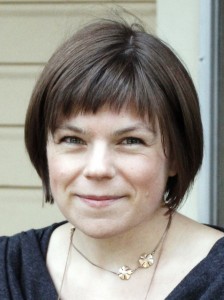10 June 2014
2014 AGU Mass Media Fellow to Report Science for the Los Angeles Times
Posted by mcadams
By Mary Catherine Adams

Geologist Julia Rosen will spend 10 weeks this summer working as a science reporter for the Los Angeles Times as the 2014 AGU-sponsored AAAS Mass Media Fellow. Rosen earned her Ph.D. from Oregon State University in March. Photo courtesy of Julia Rosen.
This story also appeared in the 10 June 2014 issue of Eos.
You could say many geoscientists are in the business of storytelling. They use strata of stone, ice, and other terrestrial ingredients to tell tales of the Earth as it was long ago.
After unlocking stories trapped in ice core bubbles for the past 6 years to earn her Ph.D., geologist Julia Rosen now has the opportunity to polish another set of storytelling skills as AGU’s 2014 Mass Media Fellow.
The Mass Media Fellowship program, run by the American Association for the Advancement of Science (AAAS), places about 15 graduate students or recent grads in newsrooms across the United States each summer. The fellows spend 10 weeks as science reporters, working alongside professional journalists to create science news stories for broad audiences.
Like many college freshmen, Rosen did not know exactly what she wanted to study when she first started school. So the Stanford University freshman took advantage of the school’s “try everything and see if you like it” attitude, as she put it, dabbling in both science and humanities courses.
Spurred by a growing interest in environmental science, Rosen participated in an environmental field studies course to Alaska’s Wrangell–St. Elias National Park and Preserve in the summer after her freshman year. There, camped on a glacier, she had her “aha” moment when a geology professor began picking up rocks from a pile of glacial rubble and explaining just by looking at them where they came from.
“My mind was blown,” Rosen said, enthralled with the idea of being able to pick up a rock and immediately read a story in it about the Earth’s past.
Back again at Stanford, Rosen focused on Earth science, eventually switching from an interdisciplinary Earth systems program to geology. In particular, her heart was set on studying mountain glaciers. At the time, however, no Stanford faculty were working on them, Rosen said. So she came up with her own project to study lakes adjacent to Peruvian glaciers, completing an independent undergraduate honors research project as part of her bachelor’s degree.
For her Ph.D. work at Oregon State University, Rosen dove further into the ice.
“I’d always been fascinated with ice cores,” she said. “This idea that you can just go back through time…and learn all this information [has always been] the attraction for me.”
Part of her doctoral research focused on using ice core data to provide new clues about a climate change mystery. At the end of the last ice age (about 14,600 years ago), the global climate changed abruptly. Scientists have debated the relative timing of these changes at different latitudes in hopes of understanding the mechanism behind the change.
In professor Ed Brook’s lab at Oregon State, Rosen and her colleagues took a closer look at the air bubbles in a Greenland ice core to see how the methane gas (which is produced in low-latitude regions) and the isotopes of nitrogen gas (which reflect Greenland temperatures) trapped inside might help shed light on the debate. She built a computer model to understand how the gases become trapped in the ice and used it to analyze the data in detail.

Rosen cleans a section of the the North Greenland Eemian (NEEM) ice core before measuring the electrical conductivity of the ice in August 2009. This photo was taken at the NEEM camp in northern Greenland. Photo courtesy of Julia Rosen.
The team found that the climate near Greenland and the climate nearer the equator changed at the same time during this period, probably within a decade or two. A paper about this research appeared online in the journal Nature Geoscience on 4 May.
Rosen earned her Ph.D. from Oregon State this March. Two papers about additional ice core research she conducted there are still in the works.
During graduate school, a love of writing term papers led Rosen to experiment with writing for fun. She started a food blog and eventually began doing some science writing. She realized that her long-simmering love for unearthing stories extended beyond scientific research—a realization that brought her to the Mass Media Fellowship program.
“It kind of gets back to that original story about being in Alaska and this guy telling this story about a rock. I thought [then that] it was the rock that I loved, but now I think it was the story.”
Rosen will spend her summer writing science stories for the Los Angeles Times newspaper, starting this month.
– Mary Catherine Adams, AGU Public Information Specialist











 The Plainspoken Scientist is the science communication blog of AGU’s Sharing Science program. With this blog, we wish to showcase creative and effective science communication via multiple mediums and modes.
The Plainspoken Scientist is the science communication blog of AGU’s Sharing Science program. With this blog, we wish to showcase creative and effective science communication via multiple mediums and modes.